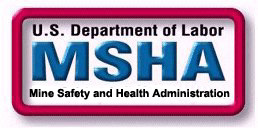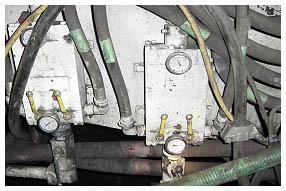| Mine Type: |
Underground Coal |
Category: |
Longwalls |

There have been 18 accidents involving hydraulic hoses in longwall incidents between 1995 and 2000. In today's dynamic longwall mines, higher productivity has been achieved by increasing the size and capacity of longwall mining equipment. Electrical and hydraulic power requirements to operate these systems have also increased over the last 20 years. In a recent accident, a longwall shearer operator was fatally injured when he was struck with a 1-1/4 inch 4,500 psi main hydraulic line with approximately 15 pounds of couplings attached.
Before retro-fitting or modifying high pressure hydraulic lines, it is important to use properly rated and sized couplers, filters, fittings, and hoses designed to handle your longwall systems specifications. Mismatched components result in using additional fittings which can increase pressure losses and increase the chance of line failure compromising safety and performance. Be sure to adhere to all government, industry, and manufacturer's specifications and standards when selecting hydraulic system components. Monitor the high pressure pump gage and the amount of emulsion used on your longwall. Hoses may have to be changed if the high pressure pump gage is fluctuating more than normal or more emulsion is being used than normal.
 After any modifications have been completed, it is critical to mount and secure hoses in a fashion that minimizes the connection point(s) exposure to bending and shearing stresses. All high pressure hydraulic hoses should be mounted keeping in mind the following:
After any modifications have been completed, it is critical to mount and secure hoses in a fashion that minimizes the connection point(s) exposure to bending and shearing stresses. All high pressure hydraulic hoses should be mounted keeping in mind the following:
1. Mounting hardware, guards, shields, and hangers must be utilized to maximize safety and performance.
2. Properly secure
each side of the connection point in a
substantial manner in the event of fitting failure
or rupture. Ask yourself,
"If this line breaks am I protected?"
3. Keep in mind that longwalls are dynamic and you must allow for enough slack in the hoses for pan and shield advancement. This will alleviate stresses placed on connection points.
4. Install hoses according to manufacturer's specifications.
The attached picture shows the proper way to secure a hydraulic filter on a high pressure line. This filter is bolted down and installed on the headgate and not subjected to bending and shearing stresses.
In summary, hydraulic hoses, fittings, filters, and
couplers should be sized and rated for your longwall systems capacity. Proper
equipment selection, sizing, routing, clamping and mounting will greatly
reduce the potential for future high pressure hydraulic system
accidents.
| Reissued: |
04/30/2002 |
| Tag # |
AP2002-S041 |
|




